Destination and Visitor Management Reflective Summary - MBA653
VerifiedAdded on 2023/01/20
|9
|2261
|75
Report
AI Summary
This report presents a student's reflective summary of their learning journey in a Tourism Management course, focusing on destination and visitor management. The student details their initial understanding of the industry, the distinction between destination and visitor management, and the importance of strategic planning. They discuss the course's impact on their understanding of cultural aspects, visitor experiences, and the role of Destination Management Organizations (DMOs). The report covers the application of learned concepts, including strategic planning, visitor satisfaction, and the inclusion of local populations. Furthermore, it outlines the student's future career aspirations, emphasizing the integration of technology, stakeholder management, and the promotion of smart tourism practices. The student reflects on the course's influence on their career goals and highlights the importance of continuous learning and adaptation in the dynamic field of tourism.
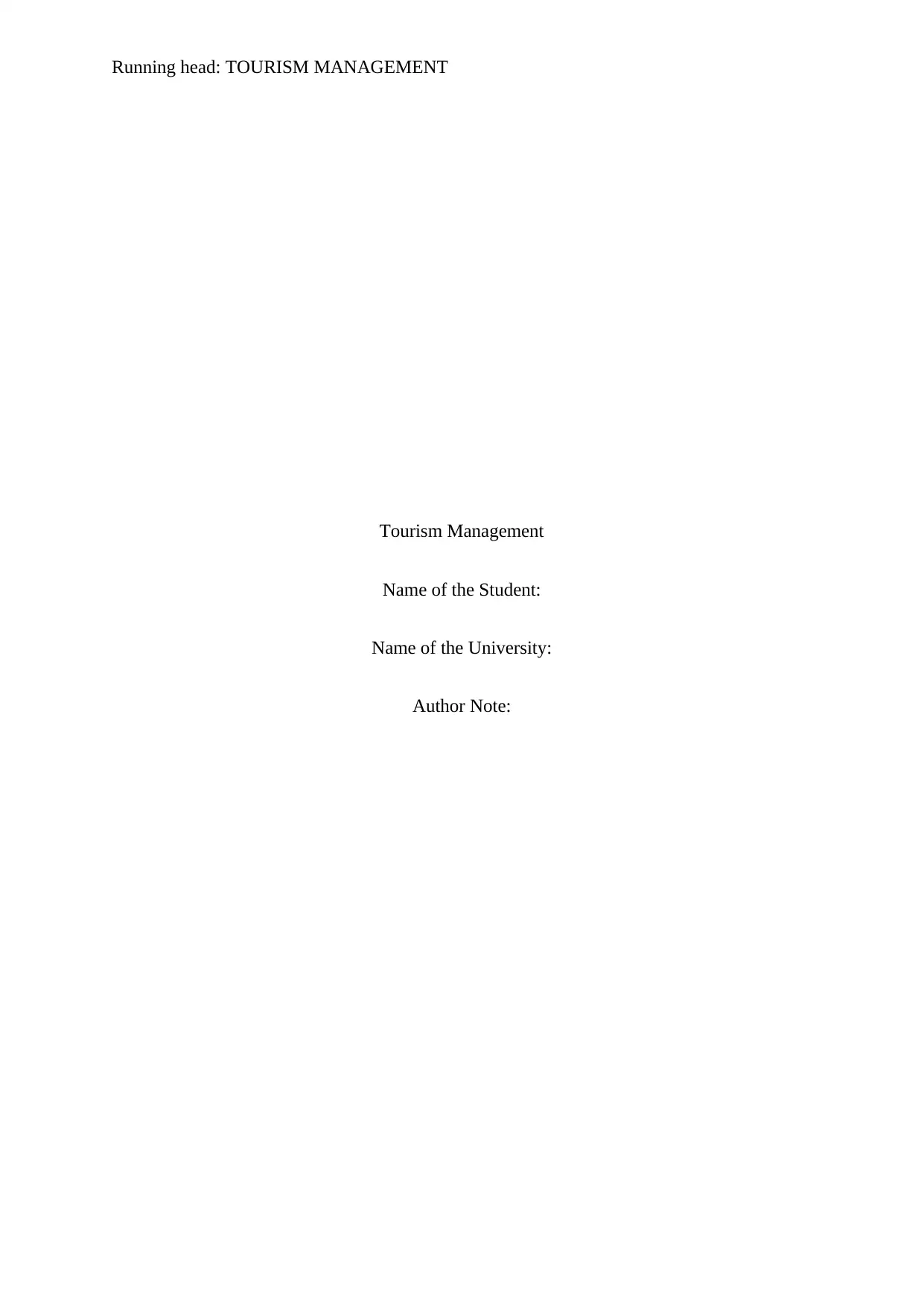
Running head: TOURISM MANAGEMENT
Tourism Management
Name of the Student:
Name of the University:
Author Note:
Tourism Management
Name of the Student:
Name of the University:
Author Note:
Paraphrase This Document
Need a fresh take? Get an instant paraphrase of this document with our AI Paraphraser
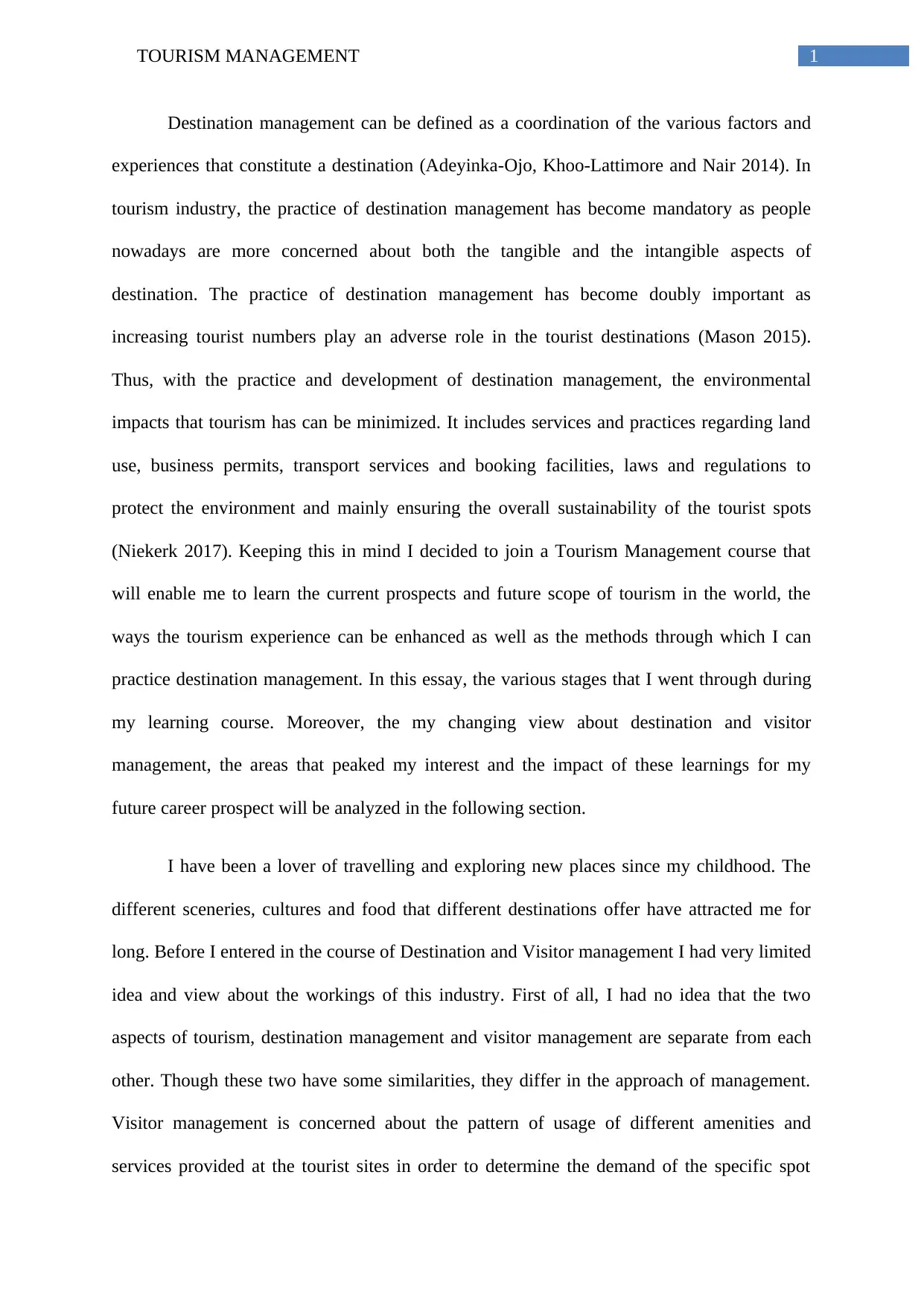
1TOURISM MANAGEMENT
Destination management can be defined as a coordination of the various factors and
experiences that constitute a destination (Adeyinka-Ojo, Khoo-Lattimore and Nair 2014). In
tourism industry, the practice of destination management has become mandatory as people
nowadays are more concerned about both the tangible and the intangible aspects of
destination. The practice of destination management has become doubly important as
increasing tourist numbers play an adverse role in the tourist destinations (Mason 2015).
Thus, with the practice and development of destination management, the environmental
impacts that tourism has can be minimized. It includes services and practices regarding land
use, business permits, transport services and booking facilities, laws and regulations to
protect the environment and mainly ensuring the overall sustainability of the tourist spots
(Niekerk 2017). Keeping this in mind I decided to join a Tourism Management course that
will enable me to learn the current prospects and future scope of tourism in the world, the
ways the tourism experience can be enhanced as well as the methods through which I can
practice destination management. In this essay, the various stages that I went through during
my learning course. Moreover, the my changing view about destination and visitor
management, the areas that peaked my interest and the impact of these learnings for my
future career prospect will be analyzed in the following section.
I have been a lover of travelling and exploring new places since my childhood. The
different sceneries, cultures and food that different destinations offer have attracted me for
long. Before I entered in the course of Destination and Visitor management I had very limited
idea and view about the workings of this industry. First of all, I had no idea that the two
aspects of tourism, destination management and visitor management are separate from each
other. Though these two have some similarities, they differ in the approach of management.
Visitor management is concerned about the pattern of usage of different amenities and
services provided at the tourist sites in order to determine the demand of the specific spot
Destination management can be defined as a coordination of the various factors and
experiences that constitute a destination (Adeyinka-Ojo, Khoo-Lattimore and Nair 2014). In
tourism industry, the practice of destination management has become mandatory as people
nowadays are more concerned about both the tangible and the intangible aspects of
destination. The practice of destination management has become doubly important as
increasing tourist numbers play an adverse role in the tourist destinations (Mason 2015).
Thus, with the practice and development of destination management, the environmental
impacts that tourism has can be minimized. It includes services and practices regarding land
use, business permits, transport services and booking facilities, laws and regulations to
protect the environment and mainly ensuring the overall sustainability of the tourist spots
(Niekerk 2017). Keeping this in mind I decided to join a Tourism Management course that
will enable me to learn the current prospects and future scope of tourism in the world, the
ways the tourism experience can be enhanced as well as the methods through which I can
practice destination management. In this essay, the various stages that I went through during
my learning course. Moreover, the my changing view about destination and visitor
management, the areas that peaked my interest and the impact of these learnings for my
future career prospect will be analyzed in the following section.
I have been a lover of travelling and exploring new places since my childhood. The
different sceneries, cultures and food that different destinations offer have attracted me for
long. Before I entered in the course of Destination and Visitor management I had very limited
idea and view about the workings of this industry. First of all, I had no idea that the two
aspects of tourism, destination management and visitor management are separate from each
other. Though these two have some similarities, they differ in the approach of management.
Visitor management is concerned about the pattern of usage of different amenities and
services provided at the tourist sites in order to determine the demand of the specific spot
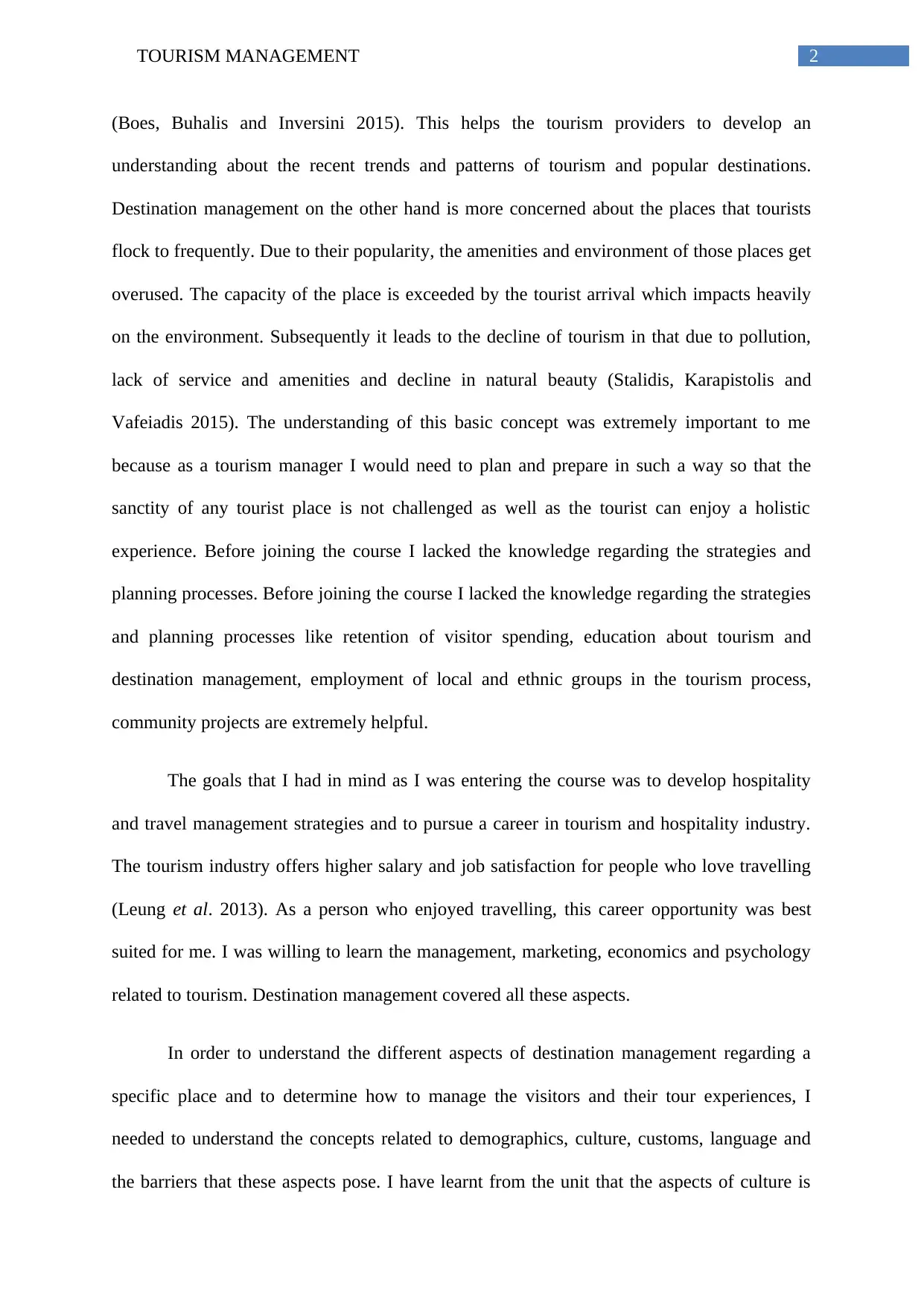
2TOURISM MANAGEMENT
(Boes, Buhalis and Inversini 2015). This helps the tourism providers to develop an
understanding about the recent trends and patterns of tourism and popular destinations.
Destination management on the other hand is more concerned about the places that tourists
flock to frequently. Due to their popularity, the amenities and environment of those places get
overused. The capacity of the place is exceeded by the tourist arrival which impacts heavily
on the environment. Subsequently it leads to the decline of tourism in that due to pollution,
lack of service and amenities and decline in natural beauty (Stalidis, Karapistolis and
Vafeiadis 2015). The understanding of this basic concept was extremely important to me
because as a tourism manager I would need to plan and prepare in such a way so that the
sanctity of any tourist place is not challenged as well as the tourist can enjoy a holistic
experience. Before joining the course I lacked the knowledge regarding the strategies and
planning processes. Before joining the course I lacked the knowledge regarding the strategies
and planning processes like retention of visitor spending, education about tourism and
destination management, employment of local and ethnic groups in the tourism process,
community projects are extremely helpful.
The goals that I had in mind as I was entering the course was to develop hospitality
and travel management strategies and to pursue a career in tourism and hospitality industry.
The tourism industry offers higher salary and job satisfaction for people who love travelling
(Leung et al. 2013). As a person who enjoyed travelling, this career opportunity was best
suited for me. I was willing to learn the management, marketing, economics and psychology
related to tourism. Destination management covered all these aspects.
In order to understand the different aspects of destination management regarding a
specific place and to determine how to manage the visitors and their tour experiences, I
needed to understand the concepts related to demographics, culture, customs, language and
the barriers that these aspects pose. I have learnt from the unit that the aspects of culture is
(Boes, Buhalis and Inversini 2015). This helps the tourism providers to develop an
understanding about the recent trends and patterns of tourism and popular destinations.
Destination management on the other hand is more concerned about the places that tourists
flock to frequently. Due to their popularity, the amenities and environment of those places get
overused. The capacity of the place is exceeded by the tourist arrival which impacts heavily
on the environment. Subsequently it leads to the decline of tourism in that due to pollution,
lack of service and amenities and decline in natural beauty (Stalidis, Karapistolis and
Vafeiadis 2015). The understanding of this basic concept was extremely important to me
because as a tourism manager I would need to plan and prepare in such a way so that the
sanctity of any tourist place is not challenged as well as the tourist can enjoy a holistic
experience. Before joining the course I lacked the knowledge regarding the strategies and
planning processes. Before joining the course I lacked the knowledge regarding the strategies
and planning processes like retention of visitor spending, education about tourism and
destination management, employment of local and ethnic groups in the tourism process,
community projects are extremely helpful.
The goals that I had in mind as I was entering the course was to develop hospitality
and travel management strategies and to pursue a career in tourism and hospitality industry.
The tourism industry offers higher salary and job satisfaction for people who love travelling
(Leung et al. 2013). As a person who enjoyed travelling, this career opportunity was best
suited for me. I was willing to learn the management, marketing, economics and psychology
related to tourism. Destination management covered all these aspects.
In order to understand the different aspects of destination management regarding a
specific place and to determine how to manage the visitors and their tour experiences, I
needed to understand the concepts related to demographics, culture, customs, language and
the barriers that these aspects pose. I have learnt from the unit that the aspects of culture is
⊘ This is a preview!⊘
Do you want full access?
Subscribe today to unlock all pages.

Trusted by 1+ million students worldwide
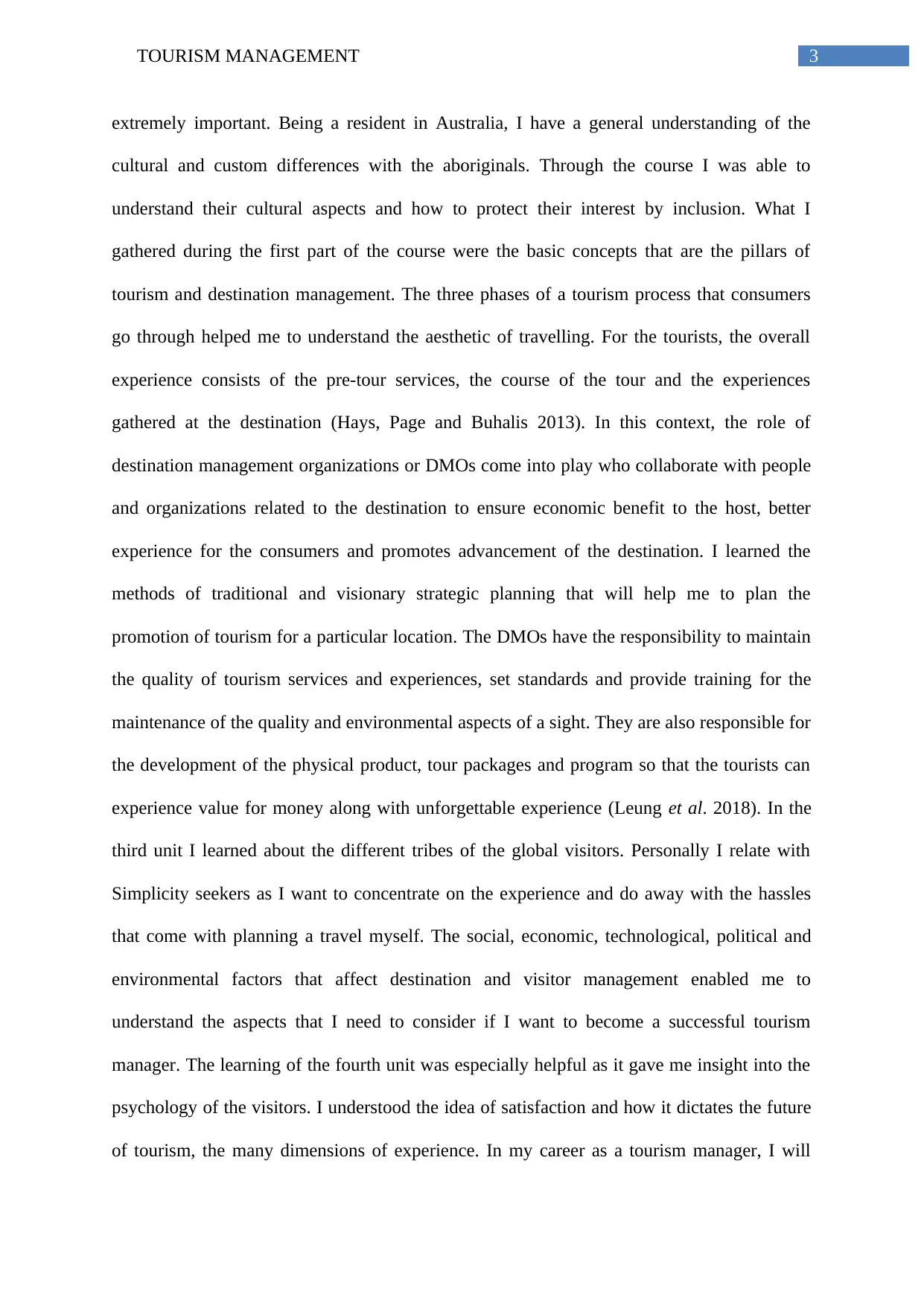
3TOURISM MANAGEMENT
extremely important. Being a resident in Australia, I have a general understanding of the
cultural and custom differences with the aboriginals. Through the course I was able to
understand their cultural aspects and how to protect their interest by inclusion. What I
gathered during the first part of the course were the basic concepts that are the pillars of
tourism and destination management. The three phases of a tourism process that consumers
go through helped me to understand the aesthetic of travelling. For the tourists, the overall
experience consists of the pre-tour services, the course of the tour and the experiences
gathered at the destination (Hays, Page and Buhalis 2013). In this context, the role of
destination management organizations or DMOs come into play who collaborate with people
and organizations related to the destination to ensure economic benefit to the host, better
experience for the consumers and promotes advancement of the destination. I learned the
methods of traditional and visionary strategic planning that will help me to plan the
promotion of tourism for a particular location. The DMOs have the responsibility to maintain
the quality of tourism services and experiences, set standards and provide training for the
maintenance of the quality and environmental aspects of a sight. They are also responsible for
the development of the physical product, tour packages and program so that the tourists can
experience value for money along with unforgettable experience (Leung et al. 2018). In the
third unit I learned about the different tribes of the global visitors. Personally I relate with
Simplicity seekers as I want to concentrate on the experience and do away with the hassles
that come with planning a travel myself. The social, economic, technological, political and
environmental factors that affect destination and visitor management enabled me to
understand the aspects that I need to consider if I want to become a successful tourism
manager. The learning of the fourth unit was especially helpful as it gave me insight into the
psychology of the visitors. I understood the idea of satisfaction and how it dictates the future
of tourism, the many dimensions of experience. In my career as a tourism manager, I will
extremely important. Being a resident in Australia, I have a general understanding of the
cultural and custom differences with the aboriginals. Through the course I was able to
understand their cultural aspects and how to protect their interest by inclusion. What I
gathered during the first part of the course were the basic concepts that are the pillars of
tourism and destination management. The three phases of a tourism process that consumers
go through helped me to understand the aesthetic of travelling. For the tourists, the overall
experience consists of the pre-tour services, the course of the tour and the experiences
gathered at the destination (Hays, Page and Buhalis 2013). In this context, the role of
destination management organizations or DMOs come into play who collaborate with people
and organizations related to the destination to ensure economic benefit to the host, better
experience for the consumers and promotes advancement of the destination. I learned the
methods of traditional and visionary strategic planning that will help me to plan the
promotion of tourism for a particular location. The DMOs have the responsibility to maintain
the quality of tourism services and experiences, set standards and provide training for the
maintenance of the quality and environmental aspects of a sight. They are also responsible for
the development of the physical product, tour packages and program so that the tourists can
experience value for money along with unforgettable experience (Leung et al. 2018). In the
third unit I learned about the different tribes of the global visitors. Personally I relate with
Simplicity seekers as I want to concentrate on the experience and do away with the hassles
that come with planning a travel myself. The social, economic, technological, political and
environmental factors that affect destination and visitor management enabled me to
understand the aspects that I need to consider if I want to become a successful tourism
manager. The learning of the fourth unit was especially helpful as it gave me insight into the
psychology of the visitors. I understood the idea of satisfaction and how it dictates the future
of tourism, the many dimensions of experience. In my career as a tourism manager, I will
Paraphrase This Document
Need a fresh take? Get an instant paraphrase of this document with our AI Paraphraser
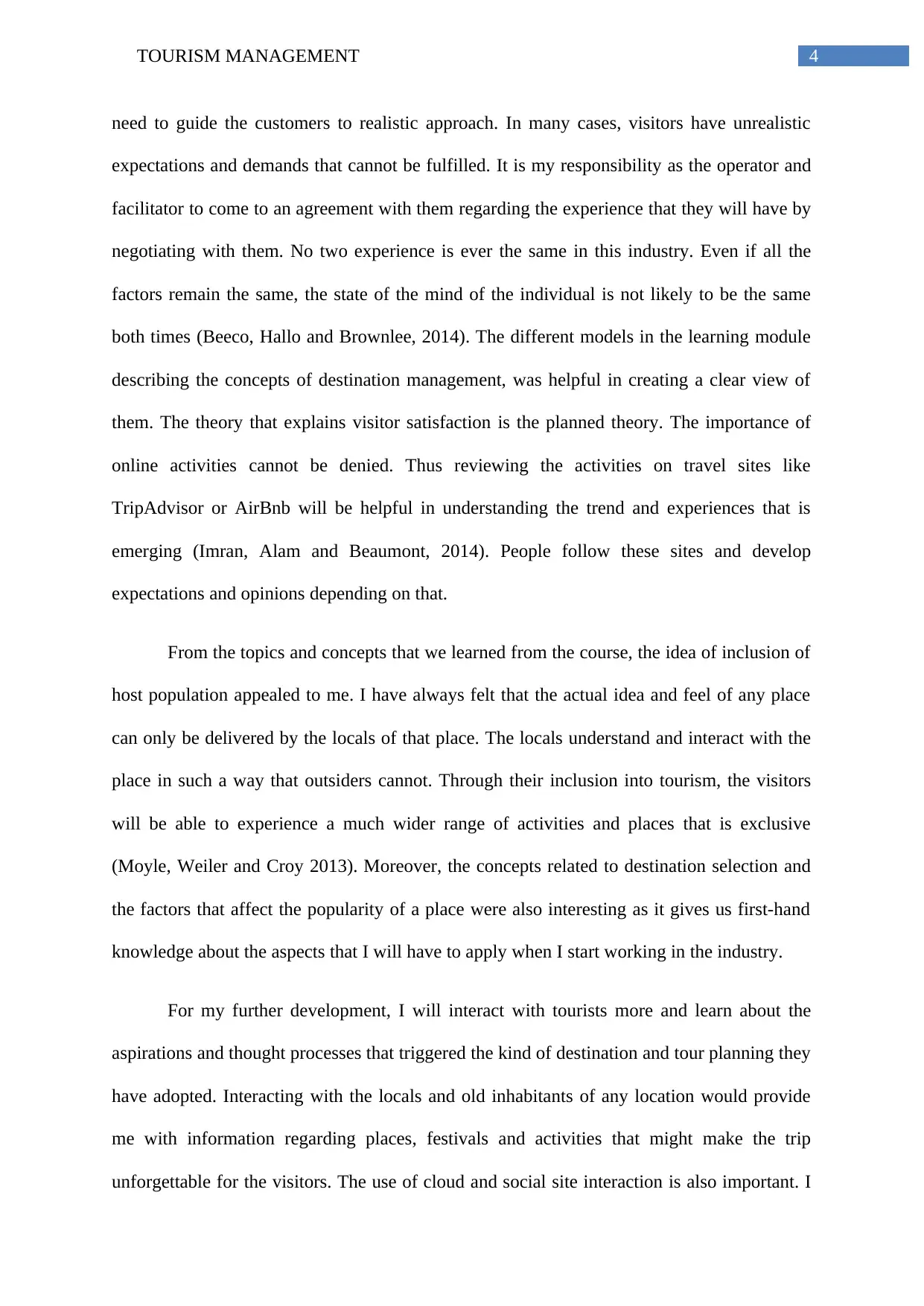
4TOURISM MANAGEMENT
need to guide the customers to realistic approach. In many cases, visitors have unrealistic
expectations and demands that cannot be fulfilled. It is my responsibility as the operator and
facilitator to come to an agreement with them regarding the experience that they will have by
negotiating with them. No two experience is ever the same in this industry. Even if all the
factors remain the same, the state of the mind of the individual is not likely to be the same
both times (Beeco, Hallo and Brownlee, 2014). The different models in the learning module
describing the concepts of destination management, was helpful in creating a clear view of
them. The theory that explains visitor satisfaction is the planned theory. The importance of
online activities cannot be denied. Thus reviewing the activities on travel sites like
TripAdvisor or AirBnb will be helpful in understanding the trend and experiences that is
emerging (Imran, Alam and Beaumont, 2014). People follow these sites and develop
expectations and opinions depending on that.
From the topics and concepts that we learned from the course, the idea of inclusion of
host population appealed to me. I have always felt that the actual idea and feel of any place
can only be delivered by the locals of that place. The locals understand and interact with the
place in such a way that outsiders cannot. Through their inclusion into tourism, the visitors
will be able to experience a much wider range of activities and places that is exclusive
(Moyle, Weiler and Croy 2013). Moreover, the concepts related to destination selection and
the factors that affect the popularity of a place were also interesting as it gives us first-hand
knowledge about the aspects that I will have to apply when I start working in the industry.
For my further development, I will interact with tourists more and learn about the
aspirations and thought processes that triggered the kind of destination and tour planning they
have adopted. Interacting with the locals and old inhabitants of any location would provide
me with information regarding places, festivals and activities that might make the trip
unforgettable for the visitors. The use of cloud and social site interaction is also important. I
need to guide the customers to realistic approach. In many cases, visitors have unrealistic
expectations and demands that cannot be fulfilled. It is my responsibility as the operator and
facilitator to come to an agreement with them regarding the experience that they will have by
negotiating with them. No two experience is ever the same in this industry. Even if all the
factors remain the same, the state of the mind of the individual is not likely to be the same
both times (Beeco, Hallo and Brownlee, 2014). The different models in the learning module
describing the concepts of destination management, was helpful in creating a clear view of
them. The theory that explains visitor satisfaction is the planned theory. The importance of
online activities cannot be denied. Thus reviewing the activities on travel sites like
TripAdvisor or AirBnb will be helpful in understanding the trend and experiences that is
emerging (Imran, Alam and Beaumont, 2014). People follow these sites and develop
expectations and opinions depending on that.
From the topics and concepts that we learned from the course, the idea of inclusion of
host population appealed to me. I have always felt that the actual idea and feel of any place
can only be delivered by the locals of that place. The locals understand and interact with the
place in such a way that outsiders cannot. Through their inclusion into tourism, the visitors
will be able to experience a much wider range of activities and places that is exclusive
(Moyle, Weiler and Croy 2013). Moreover, the concepts related to destination selection and
the factors that affect the popularity of a place were also interesting as it gives us first-hand
knowledge about the aspects that I will have to apply when I start working in the industry.
For my further development, I will interact with tourists more and learn about the
aspirations and thought processes that triggered the kind of destination and tour planning they
have adopted. Interacting with the locals and old inhabitants of any location would provide
me with information regarding places, festivals and activities that might make the trip
unforgettable for the visitors. The use of cloud and social site interaction is also important. I
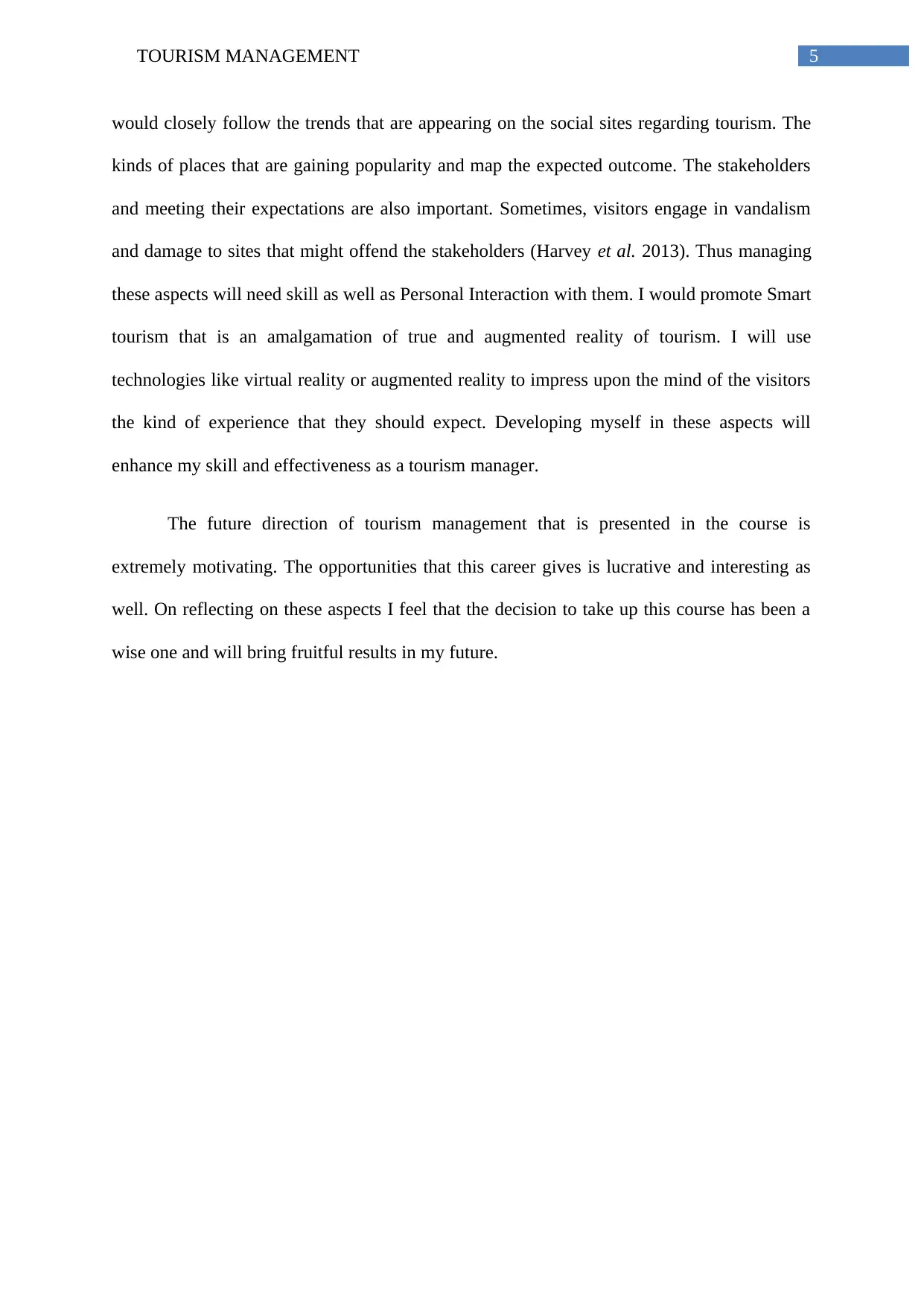
5TOURISM MANAGEMENT
would closely follow the trends that are appearing on the social sites regarding tourism. The
kinds of places that are gaining popularity and map the expected outcome. The stakeholders
and meeting their expectations are also important. Sometimes, visitors engage in vandalism
and damage to sites that might offend the stakeholders (Harvey et al. 2013). Thus managing
these aspects will need skill as well as Personal Interaction with them. I would promote Smart
tourism that is an amalgamation of true and augmented reality of tourism. I will use
technologies like virtual reality or augmented reality to impress upon the mind of the visitors
the kind of experience that they should expect. Developing myself in these aspects will
enhance my skill and effectiveness as a tourism manager.
The future direction of tourism management that is presented in the course is
extremely motivating. The opportunities that this career gives is lucrative and interesting as
well. On reflecting on these aspects I feel that the decision to take up this course has been a
wise one and will bring fruitful results in my future.
would closely follow the trends that are appearing on the social sites regarding tourism. The
kinds of places that are gaining popularity and map the expected outcome. The stakeholders
and meeting their expectations are also important. Sometimes, visitors engage in vandalism
and damage to sites that might offend the stakeholders (Harvey et al. 2013). Thus managing
these aspects will need skill as well as Personal Interaction with them. I would promote Smart
tourism that is an amalgamation of true and augmented reality of tourism. I will use
technologies like virtual reality or augmented reality to impress upon the mind of the visitors
the kind of experience that they should expect. Developing myself in these aspects will
enhance my skill and effectiveness as a tourism manager.
The future direction of tourism management that is presented in the course is
extremely motivating. The opportunities that this career gives is lucrative and interesting as
well. On reflecting on these aspects I feel that the decision to take up this course has been a
wise one and will bring fruitful results in my future.
⊘ This is a preview!⊘
Do you want full access?
Subscribe today to unlock all pages.

Trusted by 1+ million students worldwide
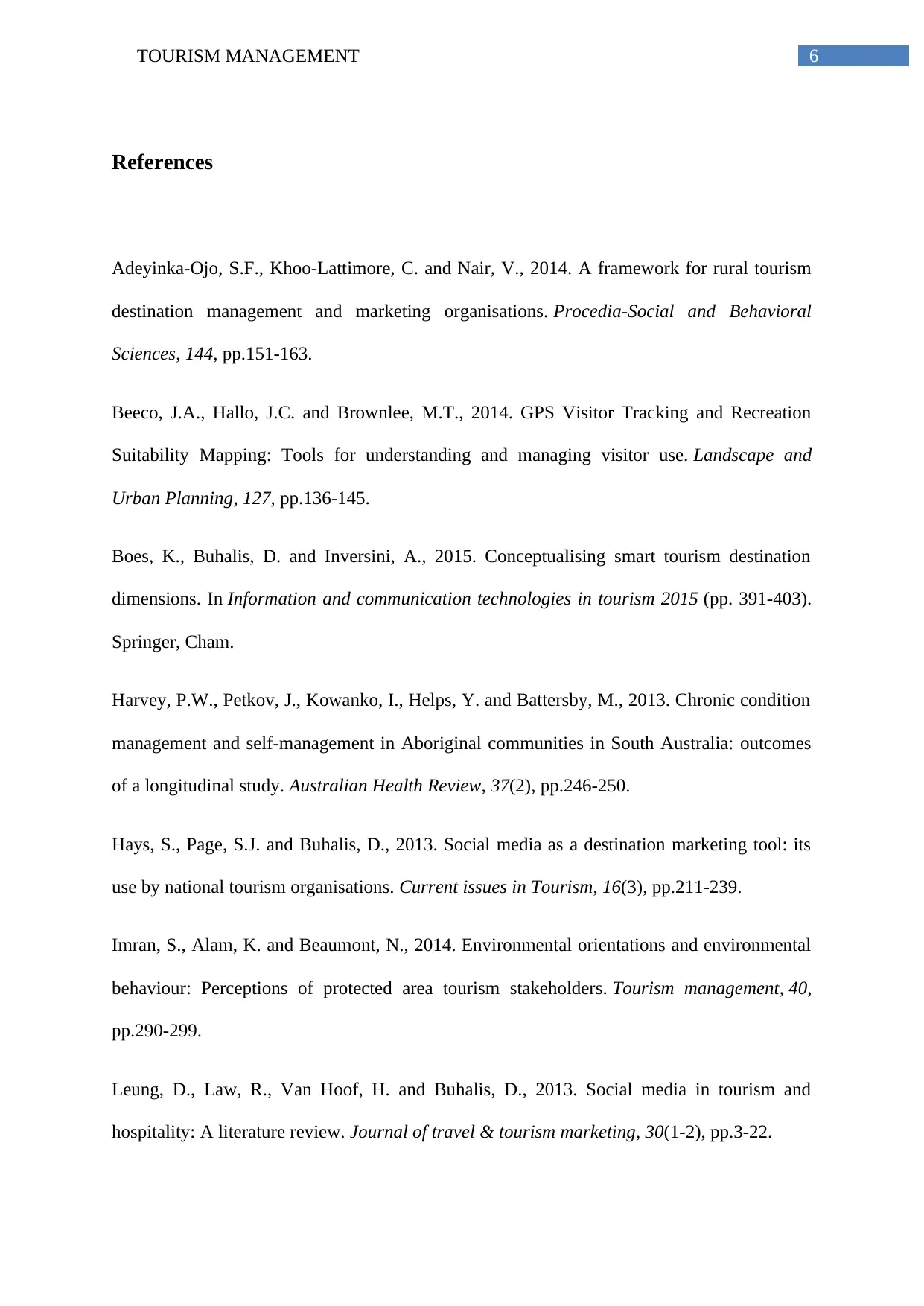
6TOURISM MANAGEMENT
References
Adeyinka-Ojo, S.F., Khoo-Lattimore, C. and Nair, V., 2014. A framework for rural tourism
destination management and marketing organisations. Procedia-Social and Behavioral
Sciences, 144, pp.151-163.
Beeco, J.A., Hallo, J.C. and Brownlee, M.T., 2014. GPS Visitor Tracking and Recreation
Suitability Mapping: Tools for understanding and managing visitor use. Landscape and
Urban Planning, 127, pp.136-145.
Boes, K., Buhalis, D. and Inversini, A., 2015. Conceptualising smart tourism destination
dimensions. In Information and communication technologies in tourism 2015 (pp. 391-403).
Springer, Cham.
Harvey, P.W., Petkov, J., Kowanko, I., Helps, Y. and Battersby, M., 2013. Chronic condition
management and self-management in Aboriginal communities in South Australia: outcomes
of a longitudinal study. Australian Health Review, 37(2), pp.246-250.
Hays, S., Page, S.J. and Buhalis, D., 2013. Social media as a destination marketing tool: its
use by national tourism organisations. Current issues in Tourism, 16(3), pp.211-239.
Imran, S., Alam, K. and Beaumont, N., 2014. Environmental orientations and environmental
behaviour: Perceptions of protected area tourism stakeholders. Tourism management, 40,
pp.290-299.
Leung, D., Law, R., Van Hoof, H. and Buhalis, D., 2013. Social media in tourism and
hospitality: A literature review. Journal of travel & tourism marketing, 30(1-2), pp.3-22.
References
Adeyinka-Ojo, S.F., Khoo-Lattimore, C. and Nair, V., 2014. A framework for rural tourism
destination management and marketing organisations. Procedia-Social and Behavioral
Sciences, 144, pp.151-163.
Beeco, J.A., Hallo, J.C. and Brownlee, M.T., 2014. GPS Visitor Tracking and Recreation
Suitability Mapping: Tools for understanding and managing visitor use. Landscape and
Urban Planning, 127, pp.136-145.
Boes, K., Buhalis, D. and Inversini, A., 2015. Conceptualising smart tourism destination
dimensions. In Information and communication technologies in tourism 2015 (pp. 391-403).
Springer, Cham.
Harvey, P.W., Petkov, J., Kowanko, I., Helps, Y. and Battersby, M., 2013. Chronic condition
management and self-management in Aboriginal communities in South Australia: outcomes
of a longitudinal study. Australian Health Review, 37(2), pp.246-250.
Hays, S., Page, S.J. and Buhalis, D., 2013. Social media as a destination marketing tool: its
use by national tourism organisations. Current issues in Tourism, 16(3), pp.211-239.
Imran, S., Alam, K. and Beaumont, N., 2014. Environmental orientations and environmental
behaviour: Perceptions of protected area tourism stakeholders. Tourism management, 40,
pp.290-299.
Leung, D., Law, R., Van Hoof, H. and Buhalis, D., 2013. Social media in tourism and
hospitality: A literature review. Journal of travel & tourism marketing, 30(1-2), pp.3-22.
Paraphrase This Document
Need a fresh take? Get an instant paraphrase of this document with our AI Paraphraser
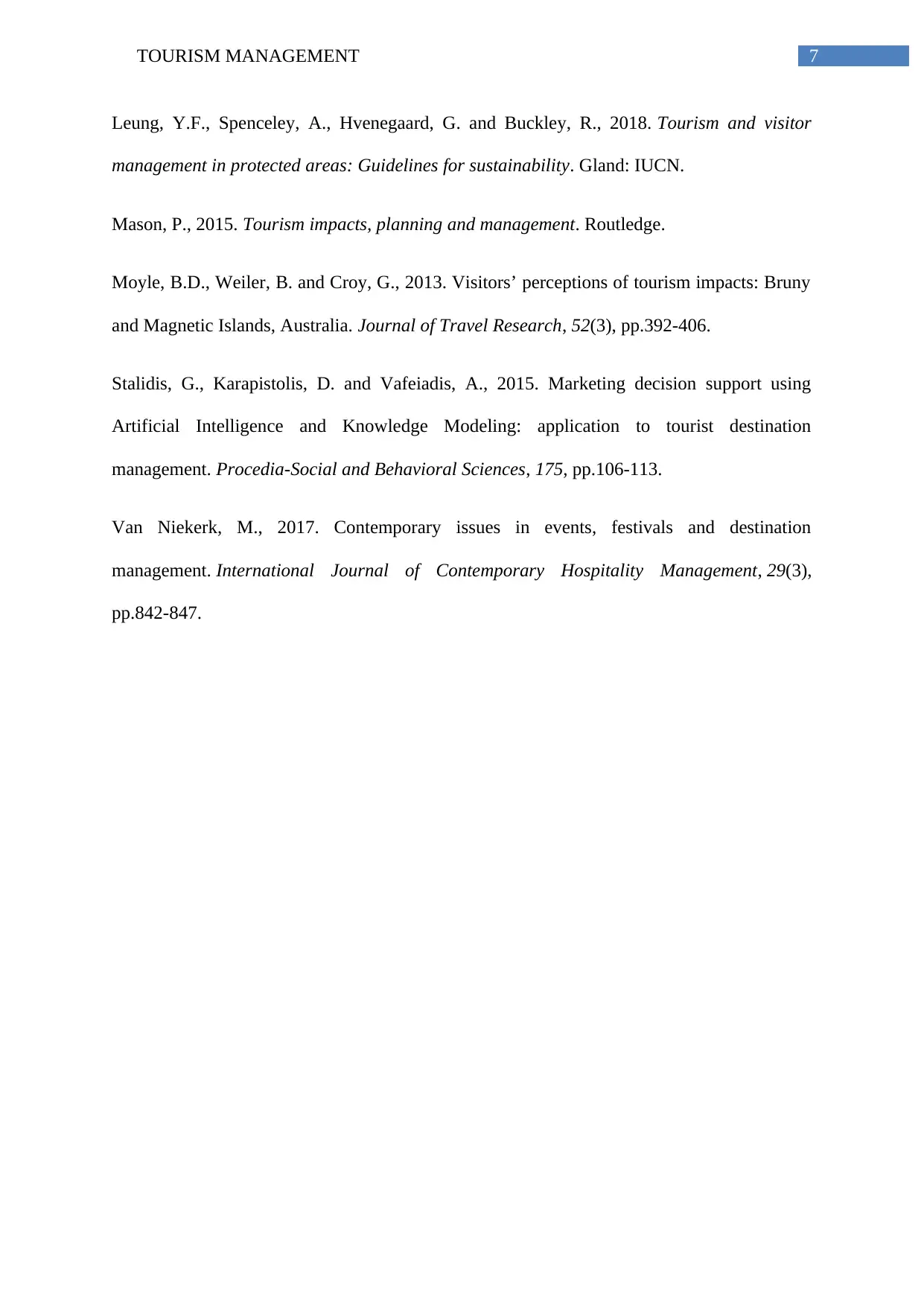
7TOURISM MANAGEMENT
Leung, Y.F., Spenceley, A., Hvenegaard, G. and Buckley, R., 2018. Tourism and visitor
management in protected areas: Guidelines for sustainability. Gland: IUCN.
Mason, P., 2015. Tourism impacts, planning and management. Routledge.
Moyle, B.D., Weiler, B. and Croy, G., 2013. Visitors’ perceptions of tourism impacts: Bruny
and Magnetic Islands, Australia. Journal of Travel Research, 52(3), pp.392-406.
Stalidis, G., Karapistolis, D. and Vafeiadis, A., 2015. Marketing decision support using
Artificial Intelligence and Knowledge Modeling: application to tourist destination
management. Procedia-Social and Behavioral Sciences, 175, pp.106-113.
Van Niekerk, M., 2017. Contemporary issues in events, festivals and destination
management. International Journal of Contemporary Hospitality Management, 29(3),
pp.842-847.
Leung, Y.F., Spenceley, A., Hvenegaard, G. and Buckley, R., 2018. Tourism and visitor
management in protected areas: Guidelines for sustainability. Gland: IUCN.
Mason, P., 2015. Tourism impacts, planning and management. Routledge.
Moyle, B.D., Weiler, B. and Croy, G., 2013. Visitors’ perceptions of tourism impacts: Bruny
and Magnetic Islands, Australia. Journal of Travel Research, 52(3), pp.392-406.
Stalidis, G., Karapistolis, D. and Vafeiadis, A., 2015. Marketing decision support using
Artificial Intelligence and Knowledge Modeling: application to tourist destination
management. Procedia-Social and Behavioral Sciences, 175, pp.106-113.
Van Niekerk, M., 2017. Contemporary issues in events, festivals and destination
management. International Journal of Contemporary Hospitality Management, 29(3),
pp.842-847.
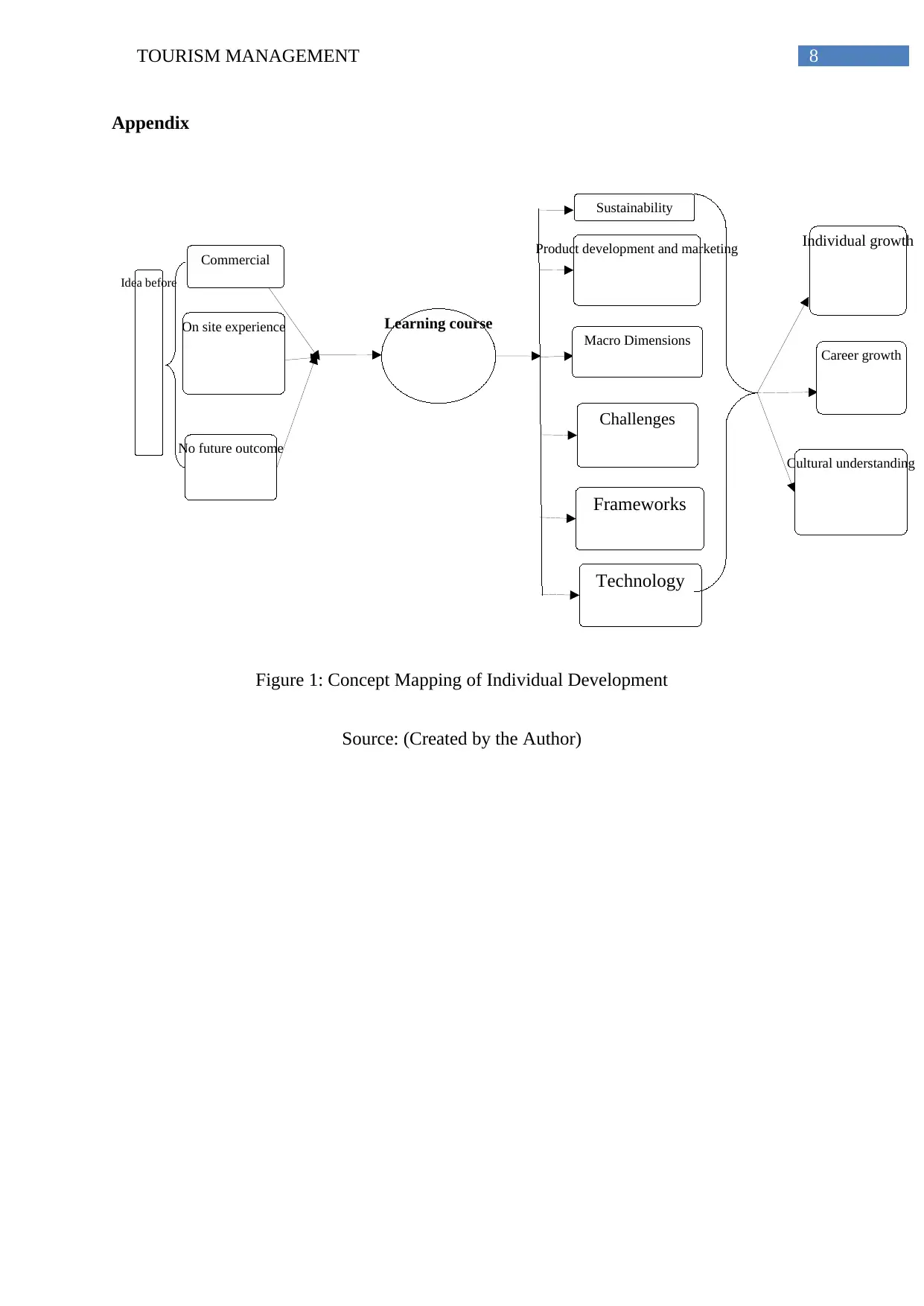
8TOURISM MANAGEMENT
Commercial
On site experience
No future outcome
Learning course
Sustainability
Product development and marketing
Macro Dimensions
Challenges
Frameworks
Technology
Individual growth
Career growth
Cultural understanding
Idea before
Appendix
Figure 1: Concept Mapping of Individual Development
Source: (Created by the Author)
Commercial
On site experience
No future outcome
Learning course
Sustainability
Product development and marketing
Macro Dimensions
Challenges
Frameworks
Technology
Individual growth
Career growth
Cultural understanding
Idea before
Appendix
Figure 1: Concept Mapping of Individual Development
Source: (Created by the Author)
⊘ This is a preview!⊘
Do you want full access?
Subscribe today to unlock all pages.

Trusted by 1+ million students worldwide
1 out of 9
Related Documents
Your All-in-One AI-Powered Toolkit for Academic Success.
+13062052269
info@desklib.com
Available 24*7 on WhatsApp / Email
![[object Object]](/_next/static/media/star-bottom.7253800d.svg)
Unlock your academic potential
Copyright © 2020–2025 A2Z Services. All Rights Reserved. Developed and managed by ZUCOL.




